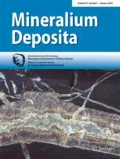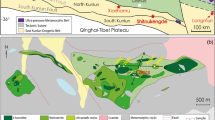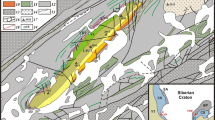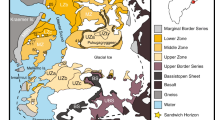Abstract
Oxygen fugacity is a key parameter in controlling the petrogenesis of mafic-ultramafic rocks and their associated sulfide mineralization, especially in convergent settings. This study uses new and previously published experimental data on olivine-sulfide pairs to reparameterize an expression for oxygen barometry using the distribution coefficient K D FeNi for Fe-Ni exchange between olivine and sulfide. We derive a new expression, ΔQFM = (9.775 + 0.416 ∙ C Ni − K D FeNi)/4.308, where ΔQFM denotes divergence from the fayalite–magnetite–quartz buffer. The revised oxygen barometry has been applied to the Permian magmatic Ni–Cu deposits in the Central Asian Orogenic Belt, NW China. The Ni–Cu deposits in the East Tianshan—North Tianshan, Central Tianshan, and Beishan—are considered as a single mineral system, whereas the spatially separated deposits in the East Junggar are considered as a separate system. The deposit of the East Tianshan group exhibits a large range of oxygen fugacity (QFM − 2 to ~QFM + 1) and Ni tenor (metal concentration in pure sulfide, ~ 5 to 16 wt%). The Poyi and Huangshannan deposits contain high-Ni tenor sulfides, varying from 12 to 16 wt%. The relatively high Fo values (> 85 mol%) and Ni contents (> 2000 ppm) in olivine of these deposits indicate that the high-Ni tenor sulfides were segregated from less differentiated high-Ni magmas that also had relatively high oxygen fugacity (~QFM + 1). The remaining Ni–Cu deposits in the East Tianshan—the Huangshandong, Huangshanxi, Hulu, Tulaergen, Tudun, and Xiangshanzhong deposits—have intermediate Ni tenors (5–8 wt%). These sulfides correspond to intermediate Fo values (80–84 mol%) and Ni contents (700–1400 ppm) in the coexisting olivine, illustrating that they were segregated from magmas with lower Ni contents thought to be the result of a large amount (15–20%) of olivine fractionation at depth. These magmas are more reduced (− 2 < ΔQFM < + 0.3) than the less evolved magmas (~QFM + 1). It is shown that the ΔQFM value calculated for the deposits in East Tianshan decreases with decreasing Fo value, indicating that the host magmas became gradually reduced during evolution, which can be explained by primarily oxidizing magma progressively assimilating crustal material containing reducing agents, such as carbon. The Kalatongke deposit in the East Junggar belt, with the lowest Ni tenors in sulfides (3–5 wt%) and low Fo values in olivine (< 78 mol%), was derived from relatively oxidizing magmas (~QFM + 1) that had experienced significant olivine plus clinopyroxene and plagioclase fractionation at depth. We propose that the variation in oxygen fugacity and Ni tenor in the Permian Ni–Cu deposits in the Central Asian Orogenic Belt is the result of gradual contamination and a variable degree of fractional crystallization.















Similar content being viewed by others
References
Asimow PD, Ghiorso MS (1998) Algorithmic modifications extending MELTS to calculate subsolidus phase relations. Am Mineral 83:1127–1132
Barnes SJ (1986) The effect of trapped liquid crystallization on cumulus mineral compositions in layered intrusions. Contrib Mineral Petr 93:524–531. https://doi.org/10.1007/BF00371722
Barnes SJ, Naldrett AJ (1985) Geochemistry of the J-M (Howland) Reef of the Stillwater Complex, Minneapolis Adit area; I, sulfide chemistry and sulfide-olivine equilibrium. Econ Geol 80:627–645. https://doi.org/10.2113/gsecongeo.80.3.627
Barnes SJ, Osborne GA, Cook D, Barnes L, Maier WD, Godel B (2011) The Santa Rita nickel sulfide deposit in the Fazenda Mirabela intrusion, Bahia, Brazil: geology, sulfide geochemistry, and genesis. Econ Geol 106:1083–1110. https://doi.org/10.2113/econgeo.106.7.1083
Barnes SJ, Godel B, Gürer D, Brenan JM, Robertson J, Paterson D (2013) Sulfide-olivine Fe-Ni exchange and the origin of anomalously Ni-rich magmatic sulfides. Econ Geol 108:1971–1982. https://doi.org/10.2113/econgeo.108.8.1971
Barnes SJ, Cruden AR, Arndt N, Saumur BM (2016) The mineral system approach applied to magmatic Ni–Cu–PGE sulphide deposits. Ore Geol Rev 76:296–316. https://doi.org/10.1016/j.oregeorev.2015.06.012
Barnes SJ, Mungall JE, Le Vaillant M, Godel B, Lesher CM, Holwell DA, Lightfoot PC, Krivolutskaya NA, Wei B (2017) Sulfide-silicate textures in magmatic Ni-Cu-PGE sulfide ore deposits. 1. Disseminated and net-textured ores. Am Mineral 102:473–506. https://doi.org/10.2138/am-2017-5754
BGMRXUAR (Bureau of Geology and Mineral Resources of Xinjiang Uygur Autonomous Region) (1993) Regional geology of Xinjiang Uygur Autonomous Region. Geological Publishing House, Beijing, pp 1–841
Botcharnikov R, Almeev R, Koepke J, Holtz F (2008) Phase relations and liquid lines of descent in hydrous ferrobasalt—implications for the Skaergaard intrusion and Columbia River flood basalts. J Petrol 49:1687–1727
Brenan JM (2003) Effects of fO2, fS2, temperature, and melt composition on Fe-Ni exchange between olivine and sulfide liquid: implications for natural olivine–sulfide assemblages. Geochim Cosmochim Acta 67:2663–2681. https://doi.org/10.1016/s0016-7037(02)01416-3
Brenan JM, Caciagli NC (2000) Fe–Ni exchange between olivine and sulphide liquid: implications for oxygen barometry in sulphide-saturated magmas. Geochim Cosmochim Acta 64:307–320. https://doi.org/10.1016/S0016-7037(99)00278-1
Brenan JM, Li C (2000) Constraints on oxygen fugacity during sulfide segregation in the Voisey’s Bay intrusion, Labrador, Canada. Econ Geol 95:901–915. https://doi.org/10.2113/gsecongeo.95.4.901
Chai F, Zhang Z, Mao J, Dong L, Zhang Z, Wu H (2008) Geology, petrology and geochemistry of the Baishiquan Ni–Cu-bearing mafic–ultramafic intrusions in Xinjiang, NW China: Implications for tectonics and genesis of ores. J Asian Earth Sci 32:218–235. https://doi.org/10.1016/j.jseaes.2007.10.014
Deng Y-F, Song X-Y, Chen L-M, Zhou T, Pirajno F, Yuan F, Xie W, Zhang D (2014) Geochemistry of the Huangshandong Ni–Cu deposit in northwestern China: implications for the formation of magmatic sulfide mineralization in orogenic belts. Ore Geol Rev 56:181–198. https://doi.org/10.1016/j.oregeorev.2013.08.012
Deng Y-F, Song X-Y, Hollings P, Zhou T, Yuan F, Chen L-M, Zhang D (2015) Role of asthenosphere and lithosphere in the genesis of the Early Permian Huangshan mafic–ultramafic intrusion in the Northern Tianshan, NW China. Lithos 227:241–254. https://doi.org/10.1016/j.lithos.2015.04.014
Fleet ME, MacRae ND (1988) Partition of Ni between olivine and sulfide: equilibria with sulfide-oxide liquids. Contrib Mineral Petr 100:462–469. https://doi.org/10.1007/bf00371375
Frost DJ, McCammon CA (2008) The redox state of Earth’s mantle. Ann Rev Earth Planet Sci 36:389–420. https://doi.org/10.1146/annurev.earth.36.031207.124322
Gaetani GA, Grove TL (1997) Partitioning of moderately siderophile elements among olivine, silicate melt, and sulfide melt: constraints on core formation in the earth and Mars. Geochim Cosmochim Acta 61:1829–1846
Gaillard F, Scaillet B, Pichavant M, Iacono-Marziano G (2015) The redox geodynamics linking basalts and their mantle sources through space and time. Chem Geol 418:217–233. https://doi.org/10.1016/j.chemgeo.2015.07.030
Gao J-F, Zhou M-F (2013) Generation and evolution of siliceous high magnesium basaltic magmas in the formation of the Permian Huangshandong intrusion (Xinjiang, NW China). Lithos 162:128–139. https://doi.org/10.1016/j.lithos.2013.01.002
Gao JF, Zhou MF, Lightfoot PC, Wang CY, Qi L (2012) Origin of PGE-poor and Cu-rich magmatic sulfides from the Kalatongke deposit, Xinjiang, Northwest China. Econ Geol 107:481–506. https://doi.org/10.2113/econgeo.107.3.481
Grinenko L (1985) Sources of sulfur of the nickeliferous and barren gabbro-dolerite intrusions of the northwest Siberian platform. Int Geol Rev 27:695–708
Han BF, Ji JQ, Song B, Chen LH, Li Z (2004) SHRIMP zircon U-Pb ages of Kalatongke No. 1 and Huangshandong Cu-Ni-bearing mafic-ultramafic complexes, North Xinjiang, and geological implications. Chinese Sci Bull 49:2424–2429. https://doi.org/10.1360/04wd0163
Han CM, Xiao WJ, Zhao GC, Ao SJ, Zhang JE, Qu WJ, Du AD (2010) In-situ U-Pb, Hf and re-Os isotopic analyses of the Xiangshan Ni-Cu-Co deposit in Eastern Tianshan (Xinjiang), Central Asia Orogenic Belt constraints on the timing and genesis of the mineralization. Lithos 120:547–562. https://doi.org/10.1016/j.lithos.2010.09.019
Han C, Xiao W, Zhao G, Han CM, Xiao WJ, Zhao GC, Xu BX, Sakyi PA, Ao SJ, Wan B, Zhan J, Zhan ZY (2013) SIMS U-Pb zircon dating and Re-Os isotopic analysis of the Hulu Cu-Ni deposit, eastern Tianshan, Central Asian Orogenic Belt, and its geological significance. J Geosci 58:251–270
Iacono-Marziano G, Gaillard F, Scaillet B, Polozov AG, Marecal V, Pirre M, Arndt NT (2012) Extremely reducing conditions reached during basaltic intrusion in organic matter-bearing sediments. Earth Planet Sci Lett 357–358:319–326. https://doi.org/10.1016/j.epsl.2012.09.052
Iacono-Marziano G, Ferraina C, Gaillard F, Di Carlo I, Arndt NT (2017) Assimilation of sulfate and carbonaceous rocks: Experimental study, thermodynamic modeling and application to the Noril’sk-Talnakh region (Russia). Ore Geol Rev. https://doi.org/10.1016/j.oregeorev.2017.04.027
Jahn BM (2004) The Central Asian orogenic belt and growth of the continental crust in the Phanerozoic. Geol Soc Spec Publ 226:73–100. https://doi.org/10.1144/Gsl.Sp.2004.226.01.05
Jugo PJ (2009) Sulfur content at sulfide saturation in oxidized magmas. Geology 37:415–418. https://doi.org/10.1130/g25527a.1
Kiseeva ES, Wood BJ (2013) A simple model for chalcophile element partitioning between sulphide and silicate liquids with geochemical applications. Earth Planet Sci Lett 383:68–81. https://doi.org/10.1016/j.epsl.2013.09.034
Li C, Ripley EM (2010) The relative effects of composition and temperature on olivine-liquid Ni partitioning: Statistical deconvolution and implications for petrologic modeling. Chem Geol 275:99–104. https://doi.org/10.1016/j.chemgeo.2010.05.001
Li C, Ripley EM, Naldrett AJ (2003) Compositional variations of olivine and sulfur isotopes in the Noril’sk and Talnakh intrusions, Siberia: implications for ore-forming processes in dynamic magma conduits. Econ Geol 98:69–86
Li C, Zhang M, Fu P, Qian ZZ, Hu P, Ripley EM (2012) The Kalatongke magmatic Ni-Cu deposits in the Central Asian Orogenic Belt, NW China: product of slab window magmatism? Miner Deposita 47:51–67. https://doi.org/10.1007/s00126-011-0354-7
Li X, Wang D, Zhao S (2014) The discovery of Baixintan magmatic Ni-Cu sulfide deposits in Hami Area, Xinjiang. Xinjiang Geol 32:466–469
Li C, Zhang Z, Li W, Wang Y, Sun T, Ripley EM (2015) Geochronology, petrology and Hf–S isotope geochemistry of the newly-discovered Xiarihamu magmatic Ni–Cu sulfide deposit in the Qinghai–Tibet plateau, western China. Lithos 216–217:224–240. https://doi.org/10.1016/j.lithos.2015.01.003
Lightfoot PC, Evans-Lamswood D (2015) Structural controls on the primary distribution of mafic–ultramafic intrusions containing Ni–Cu–Co–(PGE) sulfide mineralization in the roots of large igneous provinces. Ore Geol Rev 64:354–386. https://doi.org/10.1016/j.oregeorev.2014.07.010
Maier W, Groves D (2011) Temporal and spatial controls on the formation of magmatic PGE and Ni–Cu deposits. Mineral Deposita 46:841–857. https://doi.org/10.1007/s00126-011-0339-6
Maier WD, Smithies RH, Spaggiari CV, Barnes SJ, Kirkland CL, Yang S, Lahaye Y, Kiddie O, MacRae C (2016) Petrogenesis and Ni-Cu sulphide potential of mafic-ultramafic rocks in the Mesoproterozoic Fraser Zone within the Albany-Fraser Orogen, Western Australia. Precambrian Res. https://doi.org/10.1016/j.precamres.2016.05.004
Mao JW, Pirajno F, Zhang ZH, Chai FM, Wu H, Chen SP, Cheng LS, Yang JM, Zhang CQ (2008) A review of the Cu-Ni sulphide deposits in the Chinese Tianshan and Altay orogens (Xinjiang Autonomous Region, NW China): principal characteristics and ore-forming processes. J Asian Earth Sci 32:184–203. https://doi.org/10.1016/j.jseaes.2007.10.006
Mao Y-J, Qin K-Z, Tang D, Xue S-C, Tian Y, Feng H (2014a) Multiple phases of magma emplacement and mineralization of eastern Tianshan, Xinjiang: Examplified by Huangshan Ni-Cu deposit. Acta Petrol Sin 30:1575–1594
Mao Y-J, Qin K-Z, Li C, Xue SC, Ripley EM (2014b) Petrogenesis and ore genesis of the Permian Huangshanxi sulfide ore-bearing mafic-ultramafic intrusion in the Central Asian Orogenic Belt, western China. Lithos 200:111–125. https://doi.org/10.1016/j.lithos.2014.04.008
Mao Y-J, Qin K-Z, Li C, Tang D-M (2015) A modified genetic model for the Huangshandong magmatic sulfide deposit in the Central Asian Orogenic Belt, Xinjiang, western China. Mineral Deposita 50:65–82. https://doi.org/10.1007/s00126-014-0524-5
Mao Y-J, Qin K-Z, Tang D-M, Feng H-Y, Xue S-C (2016) Crustal contamination and sulfide immiscibility history of the Permian Huangshannan magmatic Ni-Cu sulfide deposit, East Tianshan, NW China. J Asian Earth Sci 129:22–37. https://doi.org/10.1016/j.jseaes.2016.07.028
Mao Y-J, Qin K-Z, Barnes SJ, Tang D-M, Xue S-C, Le Vaillant M (2017) Genesis of the Huangshannan high-Ni tenor magmatic sulfide deposit in the Eastern Tianshan, northwest China: Constraints from PGE geochemistry and Os–S isotopes. Ore Geol Rev. https://doi.org/10.1016/j.oregeorev.2017.05.015
Mungall JE, Brenan JM (2014) Partitioning of platinum-group elements and Au between sulfide liquid and basalt and the origins of mantle-crust fractionation of the chalcophile elements. Geochim Cosmochim Acta 125:265–289. https://doi.org/10.1016/j.gca.2013.10.002
Naldrett AJ (2004) Magmatic sulfide deposits: geology, Geochemistry and Exploration Springer: 1–727
Parkinson IJ, Arculus RJ (1999) The redox state of subduction zones: insights from arc-peridotites. Chem Geol 160:409–423
Qian ZZ, Wang JZ, Jiang CY, Jiao JG, Yan HQ, He K, Sun T (2009) Geochemistry characters of platinum-group elements and its significances on the process of mineralization in the Kalatongke Cu-Ni sulfide deposit, Xinjiang, China. Acta Petrol Sin 25:832–844
Qin K-Z, Su B-X, Sakyi PA, Tang DM, Li XH, Sun H, Xiao QH, Liu PP (2011) Sims zircon U-Pb geochronology and Sr-Nd isotopes of Ni-Cu-bearing mafic-ultramafic intrusions in Eastern tianshan and Beishan in correlation with flood basalts in Tarim basin (NW China): Constraints on a ca. 280 Ma mantle plume. Am J Sci 311:237–260. https://doi.org/10.2475/03.2011.03
Qin K-Z, Tang D-M, Su B-X, Mao Y-J, Xue S-C et al (2012) The tectonic setting, style, basic feature, relative erosion degree, ore-bearing evaluation sign, potential analysis of mineralization of Cu-Ni bearing Permian mafic-ultramafic complexes, Northern Xinjiang. Northwest Geol 45:83–116
Roeder PL, Emslie RF (1970) Olivine-liquid equilibrium. Contrib Mineral Petr 29:275–289. https://doi.org/10.1007/Bf00371276
San J, Tian B, Lei J, Kang F, Qin K, Xu X (2003) A new discovery whole rocks mineralized Cu: Ni sulfide deposit in Tulagen, Etat Tianshan, Xinjiang. Mineral Deposits 22:270
Sciortino M, Mungall JE, Muinonen J (2015) Generation of high-Ni sulfide and alloy phases during serpentinization of dunite in the Dumont Sill, Quebec. Econ Geol 110:733–761. https://doi.org/10.2113/econgeo.110.3.733
Song XY, Li XR (2009) Geochemistry of the Kalatongke Ni-Cu-(PGE) sulfide deposit, NW China: implications for the formation of magmatic sulfide mineralization in a postcollisional environment. Miner Deposita 44:303–327. https://doi.org/10.1007/s00126-008-0219-x
Song XY, Chen LM, Deng YF, Xie W (2013) Syncollisional tholeiitic magmatism induced by asthenosphere upwelling owing to slab detachment at the southern margin of the Central Asian Orogenic Belt. J Geol Soc 170:941–950. https://doi.org/10.1144/Jgs2012-130
Su B-X, Qin K-Z, Sakyi PA, Li X-H, Yang Y-H, Sun H, Tang D-M, Liu P-P, Xiao Q-H, Malaviarachchi SPK (2011) U–Pb ages and Hf–O isotopes of zircons from Late Paleozoic mafic–ultramafic units in the southern Central Asian Orogenic Belt: tectonic implications and evidence for an Early-Permian mantle plume. Gondwana Res 20:516–531. https://doi.org/10.1016/j.gr.2010.11.015
Su B-X, Qin K-Z, Tang D-M, Sakyi PA, Liu P-P, Sun H, Xiao Q-H (2013) Late Paleozoic mafic–ultramafic intrusions in southern Central Asian Orogenic Belt (NW China): insight into magmatic Ni–Cu sulfide mineralization in orogenic setting. Ore Geol Rev 51:57–73. https://doi.org/10.1016/j.oregeorev.2012.11.007
Sun H (2009) Ore-forming mechanism in conduit system and ore-bearing property evaluation for mafic–ultramafic complex in Eastern Tianshan, Xinjiang. Unpublished PhD thesis. Institute of Geology and Geophysics, Chinese Academy of Sciences. p274
Sun T, Qian ZZ, Deng YF, Li CS, Song XY, Tang QY (2013a) PGE and isotope (Hf-Sr-Nd-Pb) constraints on the origin of the Huangshandong magmatic Ni-Cu sulfide deposit in the Central Asian Orogenic Belt, northwestern China. Econ Geol 108:1849–1864. https://doi.org/10.2113/econgeo.108.8.1849
Sun T, Qian Z-Z, Li C, Xia M-Z, Yang S-H (2013b) Petrogenesis and economic potential of the Erhongwa mafic–ultramafic intrusion in the Central Asian Orogenic Belt, NW China: constraints from olivine chemistry, U–Pb age and Hf isotopes of zircons, and whole-rock Sr–Nd–Pb isotopes. Lithos 182-183:185–199. https://doi.org/10.1016/j.lithos.2013.10.004
Tang D, Qin K, Li C, Qi L, Su B, Qu W (2011) Zircon dating, Hf–Sr–Nd–Os isotopes and PGE geochemistry of the Tianyu sulfide-bearing mafic–ultramafic intrusion in the Central Asian Orogenic Belt, NW China. Lithos 126:84–98. https://doi.org/10.1016/j.lithos.2011.06.007
Tang D, Qin K, Su B, Sakyi PA, Liu Y, Mao Q, Santosh M, Ma Y (2013) Magma source and tectonics of the Xiangshanzhong mafic–ultramafic intrusion in the Central Asian Orogenic Belt, NW China, traced from geochemical and isotopic signatures. Lithos 170–171:144–163. https://doi.org/10.1016/j.lithos.2013.02.013
Tang D, Qin K, Xue S, Mao Y, Evans NJ, Niu Y, Chen J (2017) Genesis of the Permian Kemozibayi sulfide-bearing mafic-ultramafic intrusion in Altay, NW China: evidence from zircon geochronology, Hf and O isotopes and mineral chemistry. Lithos 292:49–68. https://doi.org/10.1016/j.lithos.2017.08.021
Taylor JR, Wall VJ, Pownceby MI (1992) The calibration and application of accurate redox sensors. Am Mineral 77:284–295
Tian W, Campbell IH, Allen CM, Guan P, Pan WQ, Chen M, Yu HJ, Zhu WP (2010) The Tarim picrite-basalt-rhyolite suite, a Permian flood basalt from northwest China with contrasting rhyolites produced by fractional crystallization and anatexis. Contrib Mineral Petr 160:407–425. https://doi.org/10.1007/s00410-009-0485-3
Wang RM, Zhao CL (1991) Kalatongke Cu-Ni sulfide No. 1 ore deposit in Xinjiang. Geological Publishing House, Beijing. 1–319
Wang RM, Liu DQ, Yin DT (1987) The conditions of controlling metallogeny of Cu-Ni sulfide ore deposits and the orientation of finding ore Hami, Xinjiang, China. J Mineral Petrol 7:1–152
Wang Y, Zhang Z, You M, Li X, Li K, Wang B (2015) Chronological and gechemical charcateristics of the Baixintan Ni-Cu deposit in Eastern Tianshan Mountains, Xinjiang, and their implications for Ni-Cu mineralization. Geol China 42:452–467
Xia M-Z, Jiang C-Y, Li C, Xia Z-D (2013) Characteristics of a newly discovered Ni-Cu sulfide deposit hosted in the Poyi ultramafic intrusion, Tarim Craton, NW China. Econ Geol 108:1865–1878. https://doi.org/10.2113/econgeo.108.8.1865
Xiao WJ, Windley BF, Huang BC, Han CM, Yuan C, Chen HL, Sun M, Sun S, Li JL (2009) End-Permian to mid-Triassic termination of the accretionary processes of the southern Altaids: implications for the geodynamic evolution, Phanerozoic continental growth, and metallogeny of Central Asia. Int J Earth Sci (Geol Rundsch) 98:1189–1217. https://doi.org/10.1007/s00531-008-0407-z
Xue S, Qin K, Li C, Tang D, Mao Y, Qi L, Ripley EM (2016) Geochronological, petrological, and geochemical constraints on Ni-Cu sulfide mineralization in the Poyi ultramafic-troctolitic intrusion in the northeast rim of the Tarim Craton, Western China. Econ Geol 111:1465–1484. https://doi.org/10.2113/econgeo.111.6.1465
Yang E (2015) Sediment environment and enrichment rule of ore-forming elements of Lower Cambrian balck shale Series, Kuruktag-Beishan region, Xinjiang Province. PhD thesis. China University of Geosciences, Wuhan, p 150
Yang S-H, Zhou M-F, Lightfoot PC, Xu J-F, Wang CY, Jiang C-Y, Qu W-J (2014) Re–Os isotope and platinum-group element geochemistry of the Pobei Ni–Cu sulfide-bearing mafic–ultramafic complex in the northeastern part of the Tarim Craton. Mineral Deposita 49:381–397. https://doi.org/10.1007/s00126-013-0496-x
Zhang ZC, Mao JW, Chai FM, Yan SH, Chen BL, Pirajno F (2009) Geochemistry of the Permian Kalatongke mafic intrusions, Northern Xinjiang, Northwest China: implications for the genesis of magmatic Ni-Cu sulfide deposits. Econ Geol 104:185–203
Zhang M, Li C, Fu P, Hu P, Ripley E (2011) The Permian Huangshanxi Cu–Ni deposit in western China: intrusive–extrusive association, ore genesis, and exploration implications. Mineral Deposita 46:153–170. https://doi.org/10.1007/s00126-010-0318-3
Zhao Y, Xue C, Zhao X, Yang Y, Ke J (2015) Magmatic Cu–Ni sulfide mineralization of the Huangshannan mafic–untramafic intrusion, Eastern Tianshan, China. J Asian Earth Sci 105:155–172. https://doi.org/10.1016/j.jseaes.2015.03.031
Zhao Y, Xue C, Zhao X, Yang Y, Ke J, Zu B (2016) Variable mineralization processes during the formation of the Permian Hulu Ni-Cu sulfide deposit, Xinjiang, Northwestern China. J Asian Earth Sci 126:1–13. https://doi.org/10.1016/j.jseaes.2016.04.021
Zhou MF, Lesher CM, Yang ZX, Li JW, Sun M (2004) Geochemistry and petrogenesis of 270 Ma Ni-Cu-(PGE) sulfide-bearing mafic intrusions in the Huangshan district, Eastern Xinjiang, Northwest China: implications for the tectonic evolution of the Central Asian orogenic belt. Chem Geol 209:233–257. https://doi.org/10.1016/j.chemgeo.2004.05.005
Acknowledgements
This study has been financially supported by grants from the National Key Research and Development Program of China (2017YFC0601204), the National Natural Science Foundation of China (41502095), the French agency for research (ANR project #12-JS06-0009-01), and China Postdoctoral Science Foundation (2015M570146 Ya–Jing Mao). Xinjiang Nonferrous Metal Industry Group Ltd. is thanked for access to the Ni–Cu deposits in NW China. Xue–Jun Yan, Jun–Hui Xie, Yong Wang, Bin Wang, Guan–Liang Ren, Ding–Min Guo, and Yu–Zong Liang are thanked for their sharing of knowledge of the deposits in the field work. The assistance of Ida Di Carlo and Patricia Benoist-Julliot with the SEM and the electron microprobe in Orléans is acknowledged. Guohui Chen, Tongcheng Han, and Na Guo are acknowledged for their help on best-fit calibration for the experimental data. Ya–Jing Mao acknowledges the funding of the China Scholarship Council to support the visit to CSIRO as a postdoctoral fellow. SJB acknowledges support from the CSIRO Science Plus Science Leader program. Valuable comments from Margaux Le Vaillant, Sheng-Hong Yang, and Chusi Li improved the manuscript. Editors Wolfgang Maier and Bernd Lehmann are acknowledged for their helpful suggestions and editorial handling.
Author information
Authors and Affiliations
Corresponding authors
Additional information
Editorial handling: W.D. Maier
Rights and permissions
About this article
Cite this article
Mao, Y., Qin, K., Barnes, S.J. et al. A revised oxygen barometry in sulfide-saturated magmas and application to the Permian magmatic Ni–Cu deposits in the southern Central Asian Orogenic Belt. Miner Deposita 53, 731–755 (2018). https://doi.org/10.1007/s00126-017-0771-3
Received:
Accepted:
Published:
Issue Date:
DOI: https://doi.org/10.1007/s00126-017-0771-3




